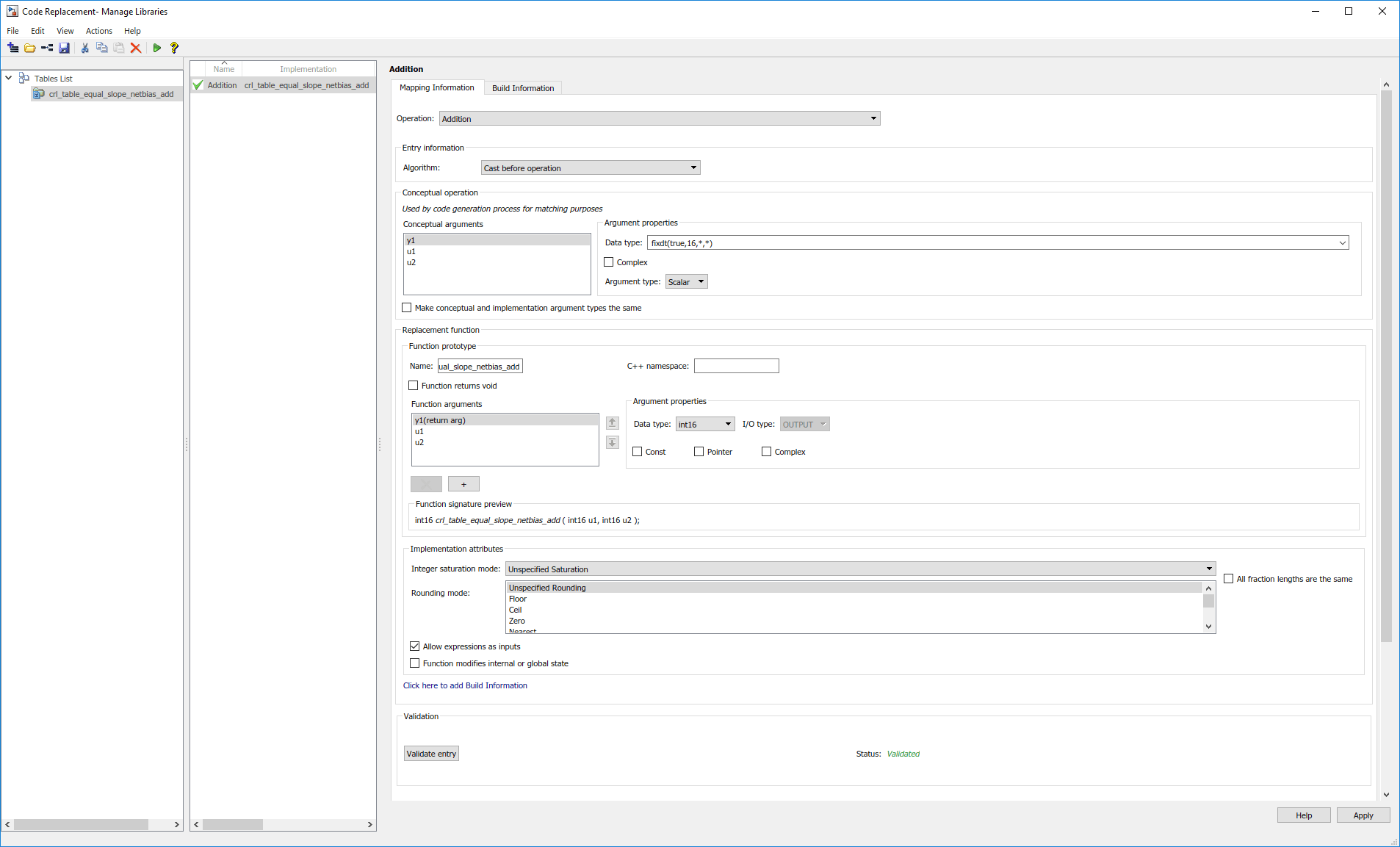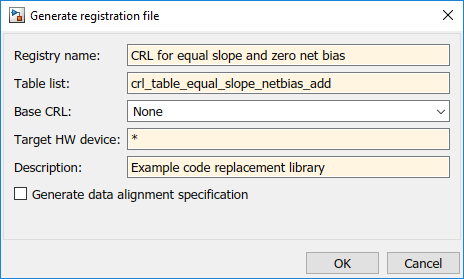Equal Slope and Zero Net Bias Code Replacement
You can define code replacement entries for addition or subtraction of fixed-point data types such that they match the relative slope and bias values (equal slope and zero net bias) across operator inputs and output. These entries allow you to disregard slope and bias values when mapping relative slope and bias values to a replacement function for addition or subtraction.
This example shows how to develop a code replacement library to optimize the
performance of fixed point net slope operations by providing
information on how to define code replacement for an addition operation.
To develop a code replacement library use either the interactive or programmatic approach. For
more information, see Develop a Code Replacement Library.
Interactively Develop a Code Replacement Library
Open the Code Replacement Tool (crtool), from the MATLAB command line with the following command:
>>crtool
Create a table.
From the toolstrip of the Code Replacement tool, click New > Table.
In the right pane, name the table
crl_table_equal_slope_netbias_add. Click Apply.
Create an entry. Click New > Entry > Net Slope Fixed-point Operation Entry.
Create entry parameters. In the Operation drop-down list, select
Addition.Create the conceptual representation. The conceptual representation describes the signature of the function that you want to replace. In the Conceptual function subsection of the crtool, specify the return argument,
y1, and the input arguments,u1andu2with the Data Type offixdt(1,16)and the Argument Type of Scalar.Create the implementation representation. The implementation representation describes the signature of the optimization function. In the Function arguments subsection of the crtool, specify the return argument,
y1, and the input arguments,u1andu2with the Data Type ofint 16.Specify the Name for the replacement function as
u16_add_SameSlopeZeroBias.Specify the Integer saturation mode as
Saturate on Overflow.Specify build information. Click the Build Information tab to open the build requirements pane. Specify the files (source, header, object) that the code generator requires for code replacement. For this example, you do not need to specify build information.
Validate and save the table. Click the Mapping Information tab and verify the fields are filled in as shown. Click Apply, then click Validate entry. On the toolstrip, click Save and save the table.

Register a code replacement library. Registration creates a library composed of the tables that you specify. Click Generate Registration File. In the Generate registration file dialog box, fill in these fields:
Registry name —
CRL for equal slope and zero net biasTable list —
crl_table_additionBase CRL —
NoneTarget HW device —
*Description —
Example code replacement library

To use your code replacement library, refresh your current MATLAB session with the command:
>>sl_refresh_customizations
Verify the code replacement library. From the MATLAB command line, open the library by using the Code Replacement Viewer and verify that the table and entry are correctly specified. For more information, see Verify Code Replacement Library. Configure your model to use the code replacement library, generate code, and verify that replacement occurs as expected. If unexpected behavior occurs, examine the hit and miss logs to troubleshoot the issues.
Programmatically Develop a Code Replacement Library
Open the programmatic interface from the MATLAB menu by selecting New > Function.
Create a table.
Create a function to call your code replacement library table. The function should not have arguments and return a table object.
Create a table object by calling
RTW.TflTable.
function hTable = crl_table_equal_slope_netbias_add % Create a function to call the code replacement library table %% Create a table object hTable = RTW.TflTable;
Create an entry. Because this example replaces a function, create a code replacement entry in your table by calling the entry function
RTW.TflCOperationEntryGenerator_NetSlope.function hTable = crl_table_equal_slope_netbias_add % Create a function to call the code replacement library table %% Create a table object hTable = RTW.TflTable; %% Create an entry hEntry = RTW.TflCOperationEntryGenerator_NetSlope;
Create entry parameters. Because this examples replaces a function, create entry parameters by calling the function
setTflCOperationEntryParameters.function hTable = crl_table_equal_slope_netbias_add % Create a function to call the code replacement library table %% Create a table object hTable = RTW.TflTable; %% Create an entry hEntry = RTW.TflCOperationEntryGenerator_NetSlope; %% Create entry parameters hEntry.setTflCOperationEntryParameters(... 'Key', 'RTW_OP_ADD', ... 'Priority', 90, ... 'SaturationMode', 'RTW_WRAP_ON_OVERFLOW', ... 'RoundingModes', {'RTW_ROUND_UNSPECIFIED'}, ... 'SlopesMustBeTheSame', true, ... 'MustHaveZeroNetBias', true, ... 'ImplementationName', 'u16_add_SameSlopeZeroBias', ... 'ImplementationHeaderFile', 'u16_add_SameSlopeZeroBias.h', ... 'ImplementationSourceFile', 'u16_add_SameSlopeZeroBias.c');
Create conceptual arguments
y1,u1, andu2. This example uses calls to thecreateAndAddConceptualArgfunction to create and add an argument with one function call. Specify each argument as fixed-point, 16 bits, and signed. Also, for each argument, specify that code replacement request processing does not check for an exact match to the call-site slope and bias values.function hTable = crl_table_equal_slope_netbias_add % Create a function to call the code replacement library table %% Create a table object hTable = RTW.TflTable; %% Create an entry hEntry = RTW.TflCOperationEntryGenerator_NetSlope; %% Create entry parameters hEntry.setTflCOperationEntryParameters(... 'Key', 'RTW_OP_ADD', ... 'Priority', 90, ... 'SaturationMode', 'RTW_WRAP_ON_OVERFLOW', ... 'RoundingModes', {'RTW_ROUND_UNSPECIFIED'}, ... 'SlopesMustBeTheSame', true, ... 'MustHaveZeroNetBias', true, ... 'ImplementationName', 'u16_add_SameSlopeZeroBias', ... 'ImplementationHeaderFile', 'u16_add_SameSlopeZeroBias.h', ... 'ImplementationSourceFile', 'u16_add_SameSlopeZeroBias.c'); %% Create the conceptual representation createAndAddConceptualArg(hEntry, 'RTW.TflArgNumeric', ... 'Name', 'y1', ... 'IOType', 'RTW_IO_OUTPUT', ... 'CheckSlope', false, ... 'CheckBias', false, ... 'IsSigned', false, ... 'WordLength', 16); createAndAddConceptualArg(hEntry, 'RTW.TflArgNumeric', ... 'Name', 'u1', ... 'IOType', 'RTW_IO_INPUT', ... 'CheckSlope', false, ... 'CheckBias', false, ... 'IsSigned', false, ... 'WordLength', 16); createAndAddConceptualArg(hEntry, 'RTW.TflArgNumeric', ... 'Name', 'u2', ... 'IOType', 'RTW_IO_INPUT', ... 'CheckSlope', false, ... 'CheckBias', false, ... 'IsSigned', false, ... 'WordLength', 16);
Create the implementation representation. The implementation representation describes the signature of the optimization function. This example uses calls to the
createAndSetCImplementationReturnfunction to create and add implementation arguments to the entry. Implementation arguments must describe fundamental numeric data types (not fixed-point data types). In this case, the output and input arguments are 16 bits and signed (int16).function hTable = crl_table_equal_slope_netbias_add % Create a function to call the code replacement library table %% Create a table object hTable = RTW.TflTable; %% Create an entry hEntry = RTW.TflCOperationEntryGenerator_NetSlope; %% Create entry parameters hEntry.setTflCOperationEntryParameters(... 'Key', 'RTW_OP_ADD', ... 'Priority', 90, ... 'SaturationMode', 'RTW_WRAP_ON_OVERFLOW', ... 'RoundingModes', {'RTW_ROUND_UNSPECIFIED'}, ... 'SlopesMustBeTheSame', true, ... 'MustHaveZeroNetBias', true, ... 'ImplementationName', 'u16_add_SameSlopeZeroBias', ... 'ImplementationHeaderFile', 'u16_add_SameSlopeZeroBias.h', ... 'ImplementationSourceFile', 'u16_add_SameSlopeZeroBias.c'); %% Create the conceptual representation createAndAddConceptualArg(hEntry, 'RTW.TflArgNumeric', ... 'Name', 'y1', ... 'IOType', 'RTW_IO_OUTPUT', ... 'CheckSlope', false, ... 'CheckBias', false, ... 'IsSigned', false, ... 'WordLength', 16); createAndAddConceptualArg(hEntry, 'RTW.TflArgNumeric', ... 'Name', 'u1', ... 'IOType', 'RTW_IO_INPUT', ... 'CheckSlope', false, ... 'CheckBias', false, ... 'IsSigned', false, ... 'WordLength', 16); createAndAddConceptualArg(hEntry, 'RTW.TflArgNumeric', ... 'Name', 'u2', ... 'IOType', 'RTW_IO_INPUT', ... 'CheckSlope', false, ... 'CheckBias', false, ... 'IsSigned', false, ... 'WordLength', 16); %% Create the Implementation Representation createAndSetCImplementationReturn(hEntry, 'RTW.TflArgNumeric', ... 'Name', 'y1', ... 'IOType', 'RTW_IO_OUTPUT', ... 'IsSigned', false, ... 'WordLength', 16, ... 'FractionLength', 0); createAndAddImplementationArg(hEntry, 'RTW.TflArgNumeric',... 'Name', 'u1', ... 'IOType', 'RTW_IO_INPUT', ... 'IsSigned', false, ... 'WordLength', 16, ... 'FractionLength', 0); createAndAddImplementationArg(hEntry, 'RTW.TflArgNumeric',... 'Name', 'u2', ... 'IOType', 'RTW_IO_INPUT', ... 'IsSigned', false, ... 'WordLength', 16, ... 'FractionLength', 0); %% Add the entry to the table addEntry(hTable, hEntry);
Specify build information. In the entry parameters, specify files (header, source, object) that the code generator needs for code replacement. For this example, build information is not required.
Validate and save the customization file. From the MATLAB menu, save this customization file by selecting File > Save. From the command line, validate the code replacement library table by calling it:
>> hTable = crl_table_equal_slope_netbias_add
Register the code replacement library. Registration creates a code replacement library by defining the library name, code replacement tables, and other information. Create a registration file with these specifications:
function rtwTargetInfo(cm) cm.registerTargetInfo(@loc_register_crl); end function this = loc_register_crl this(1) = RTW.TflRegistry; this(1).Name = 'CRL for equal slope and zero net bias code replacement'; this(1).TableList = {'crl_table_equal_slope_netbias_add.m'}; % table created in this example this(1).TargetHWDeviceType = {'*'}; this(1).Description = 'Example code replacement library'; end
To use your code replacement library, refresh your current MATLAB session with the command:
>>sl_refresh_customizations
Verify the code replacement library. From the MATLAB command line, open the library by using the Code Replacement Viewer and verify that the table and entry are correctly specified. For more information, see Verify Code Replacement Library. Configure your model to use the code replacement library, generate code, and verify that replacement occurs as expected. If unexpected behavior occurs, examine the hit and miss logs to troubleshoot the issues.